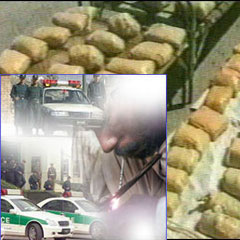 |
 |
 |
 News from Around the Americas | July 2005 News from Around the Americas | July 2005  
Mexico Now Top Supplier Of U.S. Drugs
 Pablo Bachelet - Herald.com Pablo Bachelet - Herald.com


| | Mexican drug traffickers have shoved aside their counterparts in Colombia to take control of the $400 billion illegal drug trade in the United States. |
Washington - Mexican drug traffickers have pushed aside their Colombian counterparts and now dominate the U.S. market in the biggest reorganization of the trade since the rise of the Colombian cartels in the 1980s, U.S. officials say.

Mexican groups now are behind much of the cocaine, heroin, marijuana and methamphetamine on U.S. streets, the officials say, with Mexican law enforcement agencies viewed as either too weak or too corrupt to stop them.

Mexico's role as a drug-trafficking hub has been growing for some time, but its grip on the $400-billion-a-year trade has strengthened in recent years. According to the U.S. Drug Enforcement Administration last month, 92 percent of the cocaine sold in the United States in 2004 came through the U.S.-Mexico border, compared with 77 percent in 2003.

And the Key West-based Joint Interagency Task Force South, which coordinates federal drug interdiction efforts and intelligence, has reported almost 90 percent of the cocaine heading to the U.S. market goes by boat to Mexico or other countries in Central America, and then by land to the U.S. border.

Terror Link

The increase has sparked several recent reports by DEA and other U.S. agencies, as well as hearings in both the House and Senate. Congress members, worried that the smuggling networks could be used to sneak in terrorists, are pressing the Bush administration to spend more money on programs to intercept drug shipments before they reach the border.

Officials describe the Mexican cartels as business-savvy, tight-knit family affairs that operate weblike networks of international partnerships. The Colombians cartels controlled the drug trade from its production to its wholesale distribution. The Mexicans tend to focus more on distribution, the business' most lucrative leg.

Anthony Placido, the DEA's top intelligence official told a congressional panel in June that the Mexican gangs have links to groups from Colombia, the Dominican Republic and Jamaica, and ``street gangs, prison gangs, and outlaw motorcycle gangs, who conduct most of the retail and street-level distribution throughout the country.''

The Mexicans don't control the coca or opium poppy crops in South America but are "taking ownership of [drugs] and beginning to deliver the drug themselves to Mexican distributors in the United States," said David Murray, a senior advisor with the White House's Office of National Drug Control Policy.

14 'Staging Areas'

The DEA noted 14 cities as "staging areas:" Albuquerque, Brownsville, Dallas, El Paso, Houston, Laredo, Los Angeles, McAllen, Oklahoma City, Phoenix, Tulsa, San Antonio, San Diego and Tucson.

U.S. law enforcement agencies have uncovered over 30 tunnels below the border built by drug traffickers. One congressional aide described them as "industry-standard tunnels that you would find in a mining operation."

The Mexicans also offer a more varied menu of drugs than their Colombian counterparts, who traditionally dealt in cocaine and heroin. According to the DEA, Mexico is the second-largest supplier of heroin in the United States after Colombia, and the largest foreign supplier of marijuana.

Mexican gangs also are becoming a major force in the burgeoning methamphetamine trade by setting up production laboratories on both sides of the U.S.-Mexican border. In 2004, a record 3,600 pounds of methamphetamine was seized along the south-west border, a 74 percent rise since 2001, according to DEA figures.

Placido said the administration of President Vicente Fox has had some success in undermining Mexico's traditional drug smuggling cartels and upped its cooperation with its U.S. counterparts. But new traffickers and syndicates have risen in their place.

Officials blame a turf war among Mexican drug cartels for a wave of killings and kidnappings along the Mexican side of the border that prompted the U.S. State Department to issue three travel advisories warning U.S. citizens to stay away, including one on July 26.

Clamping down on the Mexico-U.S. drug traffic is a daunting task because the border is one of the busiest in the world.

U.S. government statistics show that last year 48 million pedestrians, 90 million private vehicles and 4.4 million trucks crossed from Mexico into the United States. Another 1.1 million people were caught trying to cross.

Police Corruption

Then there's Mexico's police corruption, which Placido called the "single largest impediment to seriously impacting the drug trafficking problem in Mexico."

Congress is taking note of the problem.

Rep. Mark Souder, R-Ind., who oversees drug issues in the Committee on Government Reform, has warned that the lack of effective border controls could affect "the smuggling of people, terrorists and weapons."

Indiana Republican Sen. Richard Lugar, chairman of the Senate Foreign Relations Committee, has introduced legislation to improve security cooperation between Mexico the United States and Canada.

At a recent hearing he pointed out that 3,000 illegal migrants caught trying to cross the border last year came from "nations that have produced or have been associated with terrorist cells" such as Somalia, Pakistan and Saudi Arabia. | 
 | |
 |



